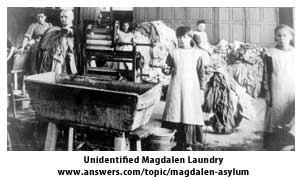The Magdalene Sisters is to Irish nuns what Mommy Dearest is to Hollywood mothers.
Peter Mullan’s controversial, occasionally brilliant, exposé of the horrifying trade in female flesh perpetrated in the 1970s by Catholic nuns in Ireland drags us through a series of atrocities that conjure images from Schindler’s List. Only, where the Speilberg film did not elicit a boycott out front of Maders or Karl Ratzsch’s, Mullan’s film may tend to encourage even more Catholic bashing than we have hitherto witnessed in this fast-paganizing land.
Mullan describes one part of the large tragedy by following the plight of four girls “imprisoned” as laundry servants in a Magdalene Asylum in 1976. Over the course of four years, they suffer the twisted tyranny of a cabal of repressed, sex-obsessed nuns and the lecherous priests who support them. The girls are shut up in this holy hell by their parents, who, cowed by the local clergy (and that nasty Catholic religion), think the nuns will make saints of their wayward girls. Actually, only two of the girls are technically “wayward.” Two others are true victims: one raped at a wedding by a popular local boy, the other spirited away from an orphanage before causing scandal, as she is too fully formed and boy-curious.

The girls (played with great conviction by Anne-Marie Duff, Nora-Jane Noone, Eileen Walsh, and Dorothy Duffy) suffer deprivation, beatings, verbal humiliation, and sexual abuse. Awful material to sit through for two hours. Especially as the sadism gets dished out under the “guidance” of one of the most villainous female characters I have ever seen in film – the pinched, thin-lipped matriarch in this dark palace of the Sisters of Mercy, Sister Bridget (played with demonic intensity by Geraldine McEwan), a figurehead who makes Big Nurse seem like Ingrid Bergman.
As a social problem film, this one has all the purgative qualities of Requiem for a Dream. It details the horrible descent into Chaos of these girls with unflinching accuracy, allowing the viewer not a single moment to take a refreshing breath. When one of the girls is rescued by her brother, instead of a sigh of relief, we get her turning on him with the line, “Where were you four [expletive] years ago.” In fact, the film’s postscript continues to ply the thumb screws, informing us that the girls all met bad ends after leaving the Asylum – one growing old, bitter, and single; one passing through three failed marriages; one descending toward madness and dying of anorexia at twenty-four; and the last marrying and living as a contented and devout Catholic.
Yes, the film suggests as much. Damn those Catholics, bad lot all. This ugly little window into a genuinely rotten chapter in the history of the Church allows no exceptions – not a single humane priest or nun so much as wipes the brow of one of the girls. All are lecherous, penurious, small-minded hypocrites who use religion as means to exploit the weak. This part stands for the whole, Mullan more than suggests.
And just there, at the self-righteous heart of this well-crafted bit of propaganda disguised as history, all sane people should pause and say, “Stop!”
Were The Magdalene Sisters a film about other groups, be they religious groups like Muslims, Jews, and New Age neo-hippies, or racial, ethnic and social groups like blacks, the Polish, and gays – we would say “stop.” But it is apparently open season on Christians now, Catholic Christians here. And, apparently, two thousand years of persecution directed against Christians throughout the world is not example enough for we enlightened Americans to learn that civilized nations can become uncivilized very rapidly.
The cruelty of this little sect of Magdalene sisters deserved to be exposed. May those who do such things to other human beings be damned, especially those who do it in the name of God.
But we had better start measuring our blows, lest in our blustering rage we strike down the virtuous with the vicious.
